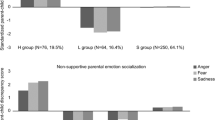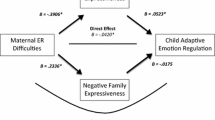Abstract
Scant research has examined links between particular emotion socialization processes and child emotion functioning cross-nationally. In this study, we assessed a sample of 55 families from the United States (U.S.; 28 boys and 27 girls) and 49 families from China (27 boys and 22 girls) on family emotional expressiveness and children’s emotional experiences and regulation. Results indicated that children and families from the U.S. reported greater emotional expressiveness than their Chinese counterparts. Children from the U.S. also reported greater undercontrolled emotion than Chinese youth. Family expression of positive emotion was related to effortful emotion regulation in U.S. youth only, whereas family expression of negative emotion was associated with undercontrolled emotion for both U.S. and Chinese children. Our findings advance context-specific models of emotional development by illustrating similarities and differences in emotional functioning among U.S. and Chinese families. From a clinical perspective, the findings suggest that practitioners should consider the cultural variations of emotion communication within families when conducting both assessment and therapy.
Similar content being viewed by others
References
Baker, A. L., Brassard, M. R., Schneiderman, M. S., Donnelly, L. J., & Bahl, A. (2011). How well do evidence-based universal parenting programs teach parents about psychological maltreatment? A program review. Child Abuse and Neglect, 35, 855–865. doi:10.1016/j.chiabu.2011.05.013.
Boyum, L. A., & Parke, R. D. (1995). The role of family emotional expressiveness in the development of children’s social competence. Journal of Marriage and the Family, 57, 593–608. doi:10.2307/353915.
Bronfenbrenner, U. (1986). Ecology of the family as a context for human development: Research perspectives. Developmental Psychology, 22, 723–742. doi:10.1037/0012-1649.22.6.723.
Butler, E. A., Lee, T. L., & Gross, J. J. (2007). Emotion regulation and culture: Are the social consequences of emotion suppression culture-specific? Emotion, 7, 30–48. doi:10.1037/1528-3542.7.1.30.
Chan, S., Bowes, J., & Wyver, S. (2009). Parenting style as a context for emotion socialization. Early Education and Development, 20, 631–656. doi:10.1080/10409280802541973.
Chang, L., Schwartz, D., Dodge, K. A., & McBride-Chang, C. (2003). Harsh parenting in relation to child emotion regulation and parenting. Journal of Family Psychology, 17, 598–606. doi:10.1037/0893-3200.17.4.598.
Chen, S. H., Zhou, Q., Eisenberg, N., Valiente, C., & Wang, Y. (2011). Parental expressivity in Chinese families: Relations to parenting styles and children’s psychological adjustment. Parenting: Science and Practice, 11, 288–307. doi:10.1080/15295192.2011.613725.
Cohen, J. (1988). Statistical power analyses for the behavioral sciences (2nd ed.). Hillsdale, NJ: Lawrence Erlbaum Associates.
Cole, P. M., & Dennis, T. A. (1998). Variations on a theme: Culture and the meaning of socialization practices and child competence. Psychological Inquiry, 9, 276–278. doi:10.1207/s15327965pli0904_3.
Cole, P., Tamang, B., & Shrestha, S. (2006). Cultural variations in the socialization of young children’s anger and shame. Child Development, 77, 1237–1251. doi:10.1111/j.1467-8624.2006.00931.x.
Cunningham, J. N., Kliewer, W., & Garner, P. W. (2009). Emotion socialization, child emotion understanding and regulation, and adjustment in urban African American families: Differential associations across child gender. Development and Psychopathology, 21, 261–283. doi:10.1017/S0954579409000157.
Davis, E., Greenberger, E., Charles, S., Chen, C., Zhao, L., & Dong, Q. (2012). Emotion experience and regulation in China and the United States: How do culture and gender shape emotion responding? International Journal of Psychology, 47, 230–239. doi:10.1080/00207594.2011.626043.
Davis, E. L., & Levine, L. J. (2012). Emotion regulation strategies that promote learning: Reappraisal enhances children’s memory for educational information. Child Development, 84, 361–374. doi:10.1111/j.1467-8624.2012.01836.x.
Denham, S., & Grout, L. (1992). Mother’s emotional expressiveness and coping: Relations with preschoolers’ social-emotional competence. Genetic, Social, and General Psychology Monographs, 118, 73–101.
Eid, M., & Diener, E. (2001). Norms for experiencing emotions in different cultures: Inter- and intra-national differences. Journal of Personality and Social Psychology, 81, 869–885. doi:10.1037//0022-3514.81.5.869.
Eisenberg, N., Pidada, S., & Liew, J. (2001). The relations of regulation and negative emotionality to Indonesian children’s social functioning. Child Development, 72, 1747–1763. doi:10.1111/1467-8624.00337.
Fung, H. (1999). Becoming a moral child: The socialization of shame among young Chinese children. Ethos, 27, 180–209. doi:10.1525/eth.1999.27.2.180.
Garner, P. W. (1995). Toddlers’ emotion regulation behaviors: The roles of social context and family expressiveness. Journal of Genetic Psychology, 156, 417–430. doi:10.1080/00221325.1995.9914834.
Gross, J. J., & Muñoz, R. F. (1995). Emotion regulation and mental health. Clinical Psychology: Science and Practice, 2, 151–164. doi:10.1111/j.1468-2850.1995.tb00036.x.
Halberstadt, A. G. (1986). Family socialization of emotional expression and nonverbal communication styles and skills. Journal of Personality and Social Psychology, 51, 827–836. doi:10.1037/0022-3514.51.4.827.
Halberstadt, A. G., & Eaton, K. L. (2003). A meta-analysis of family expressiveness and children’s emotion expressiveness and understanding. Marriage & Family Review, 34, 35–62. doi:10.1300/J002v34n01_03.
Halberstadt, A. G., & Lozada, F. T. (2011). Emotion development in infancy through the lens of culture. Emotion Review, 3, 158–168. doi:10.1177/1754073910387946.
Hatfield, E., Cacioppo, J. T., & Rapson, R. L. (1994). Emotional contagion. New York, NY: Cambridge University Press.
Hofstede, G. (1980). Cultures consequences: International differences in work-related values. Beverly Hills, CA: Sage.
Johnson, J. T. (2007). Beliefs about the emotions of self and others among Asian American and non-Asian American students: Basic similarities and the mediation of differences. Journal of Cross-Cultural Psychology, 38, 270–284. doi:10.1177/0022022107300274.
Kline, P. (2000). The handbook of psychological testing (2nd ed.). New York, NY: Routledge.
Kochenderfer-Ladd, B., & Skinner, K. (2002). Children’s coping strategies: Moderators of the effects of peer victimization? Developmental Psychology, 38, 267–278. doi:10.1037/0012-1649.38.2.267.
Laurent, J., Catanzaro, S. J., Joiner, T. R., Rudolph, K. D., Potter, K. I., Lambert, S., et al. (1999). A measure of positive and negative affect for children: Scale development and preliminary validation. Psychological Assessment, 11, 326–338. doi:10.1037/1040-3590.11.3.326.
Lewis, M., Takai-Kawakami, K., Kawakami, K., & Sullivan, M. (2010). Cultural differences in emotional responses to success and failure. International Journal of Behavioral Development, 34, 53–61. doi:10.1177/0165025409348559.
Lin, C., & Fu, V. (1990). A comparison of child rearing practices among Chinese, immigrant Chinese, and Caucasian-American parents. Child Development, 61, 429–433. doi:10.2307/1131104.
Liu, A., Wang, M., Zhang, J., & Xing, X. (2009). Relationship between family expressiveness and preschool children’s anxiety. Chinese Journal of Clinical Psychology, 17, 465–467.
Malatesta, C. Z., & Haviland, J. M. (1982). Learning display rules: The socialization of emotion expression in infancy. Child Development, 53, 991–1003. doi:10.2307/1129139.
Markus, H. R., & Kitayama, S. (1991). Culture and the self: Implications for cognition, emotion, and motivation. Psychological Review, 98, 224–253. doi:10.1037/0033-295X.98.2.224.
Matsumoto, D., & Juang, L. (2013). Culture and psychology (5th ed.). Belmont, CA: Wadsworth/Cengage Learning.
Matsumoto, D., Yoo, S. H., & Nakagawa, S. (2008). Culture, emotion regulation, and adjustment. Journal of Personality and Social Psychology, 94, 925–937. doi:10.1037/0022-3514.94.6.925.
McAuliffe, M. D., Hubbard, J. A., Rubin, R. M., Morrow, M. T., & Dearing, K. F. (2007). Reactive and proactive aggression: Stability of constructs and relations to correlates. The Journal of Genetic Psychology, 167, 365–382.
Mesquita, B., & Frijda, N. H. (1992). Cultural variations in emotions: A review. Psychological Bulletin, 112, 179–204. doi:10.1037/0033-2909.112.2.179.
Morelen, D., Zeman, J., Perry-Parrish, C., & Anderson, E. (2012). Children’s emotion regulation across and within nations: A comparison of Ghanaian, Kenyan, and American youth. British Journal of Developmental Psychology, 30, 415–431. doi:10.1111/j.2044-835x.2011.0250.x.
Morris, A. S., Silk, J. S., Steinberg, L., Myers, S. S., & Robinson, L. R. (2007). The role of the family context in the development of emotion regulation. Social Development, 16, 361–388. doi:10.1111/j.1467-9507.2007.00389.x.
Oyserman, D., Coon, H. M., & Kemmelmeier, M. (2002). Rethinking individualism and collectivism: Evaluation of theoretical assumptions and meta-analyses. Psychological Bulletin, 128, 3–72. doi:10.1037/0033-2909.128.1.3.
Ramsden, S. R., & Hubbard, J. A. (2002). Family expressiveness and parental emotion coaching: Their role in children’s emotion regulation and aggression. Journal of Abnormal Child Psychology, 30, 657–667. doi:10.1023/A:1020819915881.
Saw, A., & Okazaki, S. (2010). Family emotion socialization and affective distress in Asian American and White American college students. Asian American. Journal of Psychology, 1, 81–92. doi:10.1037/a0019638.
Shields, A. M., & Cicchetti, D. (1997). Emotion regulation among school-age children: The development of a new criterion Q-sort scale. Developmental Psychology, 33, 906–916. doi:10.1037/0012-1649.33.6.906.
Suveg, C., Sood, E., Comer, J. S., & Kendall, P. C. (2009). Changes in emotion regulation following cognitive-behavioral therapy for anxious youth. Journal of Clinical Child and Adolescent Psychology, 38, 390–401. doi:10.1080/15374410902851721.
Suveg, C., & Zeman, J. (2004). Emotion regulation in children with anxiety disorders. Journal of Clinical Child and Adolescent Psychology, 33, 750–759. doi:10.1207/s15374424jccp3304_10.
Tao, A., Zhou, Q., & Wang, Y. (2010). Parental reactions to children’s negative emotions: Prospective relations to Chinese children’s psychological adjustment. Journal of Family Psychology, 24, 135–144. doi:10.1037/a0018974.
Thompson, R. (1994). Emotion regulation: A theme in search of a definition. Emotion regulation biological and behavioral considerations. Monographs of the Society for Research in Child Development, 59, 25–52. doi:10.2307/1166137.
Vasilev, C. A., Crowell, S. E., Beauchaine, T. P., Mead, H. K., & Gatze-Kopp, L. M. (2009). Correspondence between physiological and self-report measures of emotion dysregulation: A longitudinal investigation of youth with and without psychopathology. Journal of Child Psychology and Psychiatry, 50, 1357–1364. doi:10.1111/j.1469-7610.2009.02172.x.
Wechsler, D. (1999). Wechsler abbreviated scale of intelligence. New York, NY: The Psychological Corporation, Harcourt Brace & Company.
Weidong, Z., Jing, D., & Schick, C. J. (2004). The cross-cultural measurement of positive and negative affect examining the dimensionality of PANAS. Psychological Science (China), 27, 77–79.
Wu, P., Robinson, C. C., Yang, C., Hart, C. H., Olsen, S. F., et al. (2002). Similarities and differences in mothers’ parenting of preschoolers in China and the United States. International Journal of Behavioral Development, 26, 481–491. doi:10.1080/01650250143000436.
Xu, Y., & Zhang, Z. (2008). Distinguishing proactive and reactive aggression in Chinese children. Journal of Abnormal Child Psychology, 36, 539–552. doi:10.1007/s10802-007-9198-0.
Yagmurlu, B., & Altan, O. (2010). Maternal socialization and child temperament as predictors of emotion regulation in Turkish preschoolers. Infant and Child Development, 19, 275–296. doi:10.1002/icd.646.
Zahn-Waxler, C., Friedman, R. J., Cole, P. M., Mizuta, I., & Hiruma, N. (1996). Japanese and United States preschool children’s responses to conflict and distress. Child Development, 67, 2462–2477. doi:10.2307/1131634.
Zeman, J., Shipman, K., & Penza-Clyve, S. (2001). Development and initial validation of the children’s sadness management scale. Journal of Nonverbal Behavior, 23, 187–205. doi:10.1023/A:1010623226626.
Zhou, Q., Eisenberg, N., Wang, Y., & Reiser, M. (2004). Chinese children’s effortful control and dispositional anger/frustration: Relations to parenting styles and children’ social functioning. Developmental Psychology, 40, 352–366. doi:10.1037/0012-1649.40.3.352.
Acknowledgments
This research was funded by the University of Georgia Research Foundation and the William A. and Barbara R. Owens Institute for Behavioral Research.
Author information
Authors and Affiliations
Corresponding author
Rights and permissions
About this article
Cite this article
Suveg, C., Raley, J.N., Morelen, D. et al. Child and Family Emotional Functioning: A Cross-National Examination of Families from China and the United States. J Child Fam Stud 23, 1444–1454 (2014). https://doi.org/10.1007/s10826-013-9800-8
Published:
Issue Date:
DOI: https://doi.org/10.1007/s10826-013-9800-8




